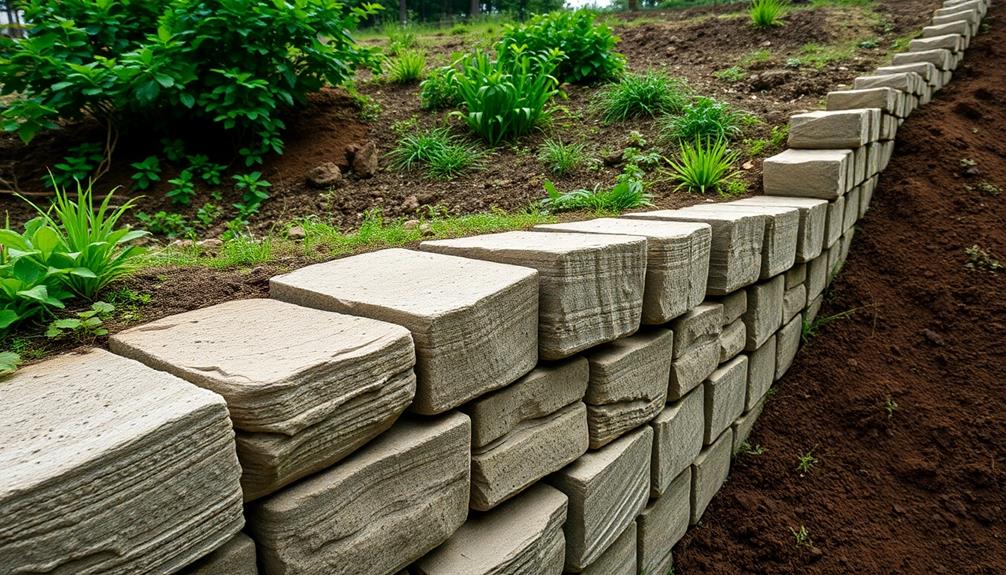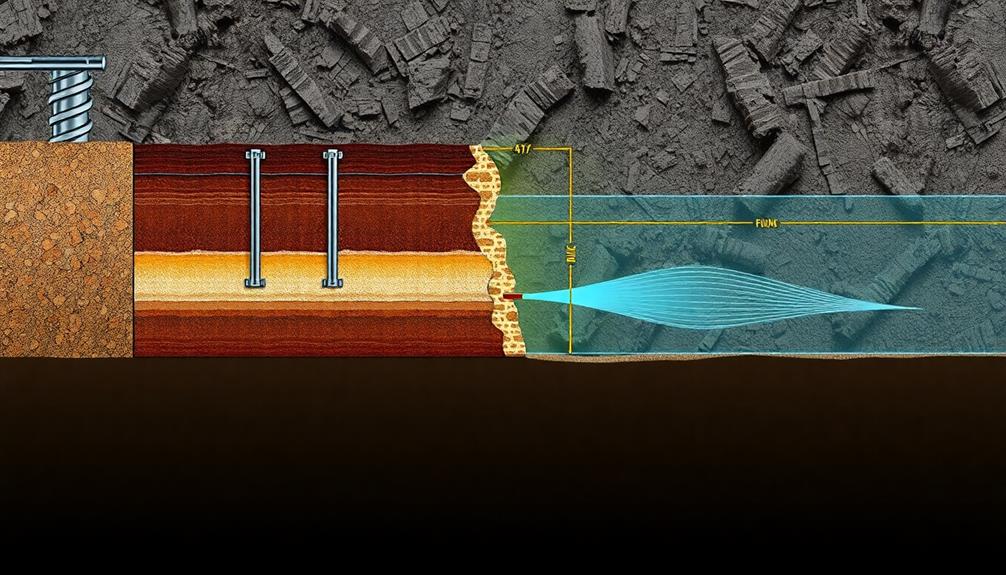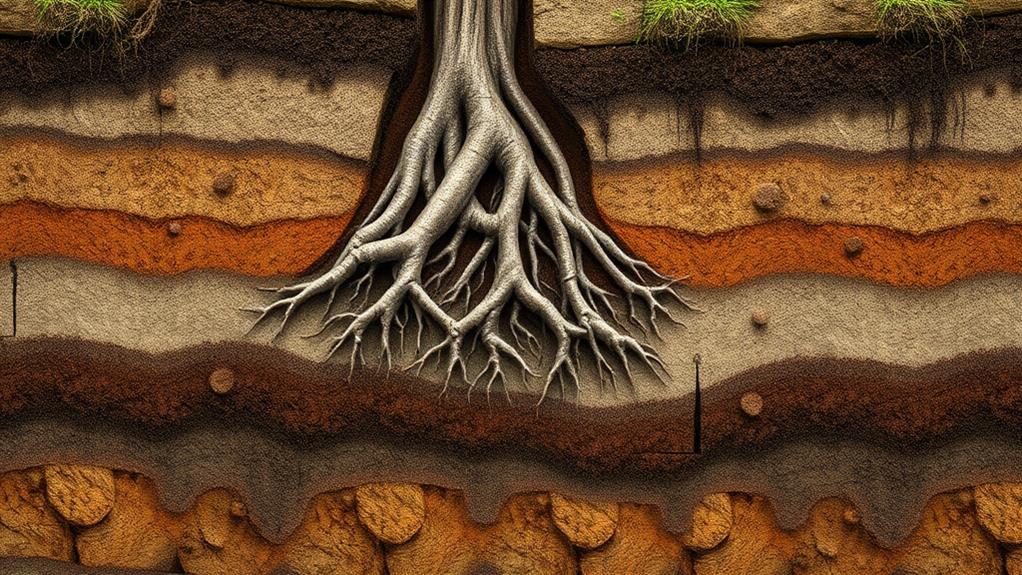Soil mechanics is fundamental to retaining wall design and construction, providing essential insights into soil behavior under various loads. It enables engineers to analyze soil composition, stress-strain relationships, and shear strength factors, ensuring optimal wall performance and longevity. By understanding these principles, designers can create cost-effective solutions that enhance safety, minimize material waste, and improve structural integrity. Soil mechanics also plays a vital role in seismic considerations, allowing for the calculation of dynamic earth pressures and the implementation of reinforcement modifications. This thorough approach to retaining wall design ultimately leads to more resilient and sustainable structures. Further exploration of soil mechanics principles reveals its far-reaching impact on geotechnical engineering practices.
Table of Contents
ToggleWalls Contractor Highlights
- Soil mechanics helps predict soil behavior under load, ensuring proper design and stability of retaining walls.
- Understanding stress-strain relationships allows engineers to calculate lateral earth pressures acting on retaining walls accurately.
- Knowledge of shear strength factors enables the design of walls that can resist deformation and failure under applied stresses.
- Soil mechanics principles guide the selection of appropriate drainage systems and backfill materials, enhancing wall performance.
- Incorporating soil mechanics in design leads to cost-effective, safe, and long-lasting retaining wall structures.
Foundational Principles of Soil Behavior

Understanding the foundational principles of soil behavior is essential for designing effective retaining walls. The composition and structure of soil, including its particle size distribution and arrangement, substantially influence its mechanical properties and response to loads.
These characteristics, combined with an analysis of stress-strain relationships and shear strength factors, form the basis for predicting soil behavior under various conditions and designing retaining structures that can withstand the forces exerted by the retained earth. Boulder retaining walls offer a powerful and natural solution for soil retention, combining both functional and aesthetic benefits. Their sheer size and unique appearance make them an appealing option for long-lasting and cost-effective retaining structures.
Soil Composition and Structure
At the core of soil mechanics lies the fundamental understanding of soil composition and structure. This knowledge forms the bedrock upon which we build our collective expertise in retaining wall construction.
Soil, a complex matrix of mineral particles, organic matter, water, and air, exhibits diverse properties that greatly influence its behavior under load. The composition of soil, including the proportions of sand, silt, and clay, dictates its physical characteristics and engineering properties.
The structure of soil, encompassing the arrangement and bonding of particles, plays an indispensable role in determining its strength, compressibility, and permeability. Soil particles can form various configurations, from loose, honeycomb structures to densely packed arrangements, each with distinct implications for retaining wall design.
Understanding these intricate relationships allows engineers to anticipate soil behavior, optimize wall designs, and mitigate potential failure modes. By delving into the microscopic world of soil particles and their interactions, we gain valuable insights that translate into safer, more efficient retaining wall systems. This knowledge empowers us to create structures that not only withstand the test of time but also harmonize with the natural environment.
Stress-Strain Relationships
Building upon our knowledge of soil composition and structure, we now explore the foundational principles of soil behavior through stress-strain relationships. These relationships are critical in understanding how soil responds to applied forces, which is essential for designing and constructing robust retaining walls.
When a load is applied to soil, it experiences deformation, or strain, in response to the stress. This relationship is non-linear and varies depending on soil type, moisture content, and loading conditions.
Engineers must consider both elastic and plastic deformations in soil. Elastic deformation occurs when the soil returns to its original shape after the load is removed, while plastic deformation results in permanent changes to the soil structure. The stress-strain curve for soil typically exhibits an initial elastic region followed by a plastic region, with a shift zone in between.
Understanding these behaviors allows engineers to predict soil settlement, bearing capacity, and lateral earth pressures acting on retaining walls. By analyzing stress-strain relationships, we can determine appropriate safety factors, design parameters, and construction techniques to guarantee the long-term stability and performance of retaining walls in various soil conditions.
Shear Strength Factors
Shear strength factors are indispensable components in determining soil behavior and stability, particularly in the context of retaining wall design. These factors encompass various soil properties that collectively influence the soil's ability to resist deformation and failure under applied stresses.
The primary shear strength factors include cohesion, internal friction angle, and normal stress. Cohesion represents the inherent bonding between soil particles, while the internal friction angle quantifies the resistance to sliding between particles. Normal stress, acting perpendicular to the shear plane, contributes to the overall shear strength by increasing frictional resistance.
Understanding these factors is pivotal for geotechnical engineers and designers working on retaining wall projects. By accurately evaluating and incorporating shear strength factors into their calculations, professionals can guarantee the long-term stability and safety of retaining structures.
The interplay between these factors and environmental conditions, such as moisture content and temperature variations, further complicates soil behavior analysis. Advanced laboratory testing methods, including direct shear tests and triaxial compression tests, allow for precise measurement of shear strength parameters, enabling engineers to develop robust and reliable retaining wall designs that withstand the complex forces exerted by soil masses.
Benefits

Applying soil mechanics principles to retaining wall design and construction yields numerous advantages that markedly enhance project outcomes. By leveraging a deep understanding of soil behavior, engineers can achieve improved structural stability, optimize design efficiency, implement enhanced safety measures, and adopt cost-effective construction practices.
Granite Company specialists with over 20 years of experience apply these principles to guarantee long-lasting and structurally sound retaining walls for Twin Cities homeowners. Their expertise in proper grading and structural reinforcements further enhances the benefits of soil mechanics application.
These benefits collectively contribute to the development of more robust, reliable, and economical retaining wall systems that effectively withstand soil pressures and environmental forces while meeting stringent safety and performance standards.
Improved Structural Stability
Numerous benefits arise from improved structural stability in retaining walls when proper soil mechanics principles are applied. By understanding and accounting for soil behavior, engineers can design retaining walls that effectively resist lateral earth pressures, minimize settlement, and maintain their integrity over time. This enhanced stability not only guarantees the longevity of the structure but also contributes to the overall safety of the surrounding environment.
The application of soil mechanics in retaining wall design offers several key advantages:
- Reduction in the risk of structural failure or collapse
- Optimized material usage, leading to cost-effective construction
- Enhanced resistance to environmental factors such as erosion and seismic activity
- Improved drainage capabilities, reducing hydrostatic pressure on the wall
Optimized Design Efficiency
When soil mechanics principles are properly integrated into retaining wall design, the result is often a significant increase in design efficiency. By thoroughly understanding the properties and behavior of soil, engineers can optimize wall dimensions, materials, and construction methods to achieve superior performance while minimizing costs. This approach allows for the creation of structures that not only meet safety requirements but also maximize resource utilization and minimize environmental impact.
The application of soil mechanics enables designers to accurately assess the lateral earth pressures acting on the wall, leading to more precise calculations of wall thickness and reinforcement requirements. This precision reduces material waste and overengineering, resulting in cost-effective solutions without compromising structural integrity. Additionally, soil mechanics principles inform the selection of appropriate drainage systems and backfill materials, enhancing long-term stability and reducing maintenance needs.
Enhanced Safety Measures
The integration of soil mechanics principles into retaining wall design markedly improves safety measures, providing numerous benefits for both the structure and its surroundings. By thoroughly analyzing soil properties, engineers can accurately predict potential failure modes and implement appropriate countermeasures. This comprehensive approach guarantees the long-term stability of retaining walls, even under challenging environmental conditions.
Enhanced safety measures derived from soil mechanics include:
- Precise calculation of lateral earth pressures
- Accurate determination of soil bearing capacity
- Ideal design of drainage systems to prevent hydrostatic pressure buildup
- Implementation of seismic resistance features in high-risk areas
These safety enhancements not only protect the structural integrity of the retaining wall but also safeguard adjacent properties and infrastructure. By incorporating sophisticated soil analysis techniques, engineers can develop more resilient designs that withstand various external forces, including earthquakes, heavy rainfall, and freeze-thaw cycles. Additionally, the application of soil mechanics principles allows for the early detection of potential issues, enabling proactive maintenance and reducing the risk of catastrophic failures. This proactive approach ultimately leads to increased public safety, reduced liability for property owners, and enhanced longevity of retaining wall structures.
Cost-Effective Construction Practices
Through the application of soil mechanics principles, retaining wall construction can achieve significant cost benefits while maintaining structural integrity. By thoroughly understanding soil properties and behavior, engineers can optimize design parameters, reducing material usage and construction time.
This approach allows for the selection of appropriate backfill materials that enhance drainage and stability, minimizing the risk of costly failures and repairs in the future.
Implementing soil mechanics in retaining wall projects enables the use of advanced analytical techniques, such as finite element analysis, to model soil-structure interactions accurately. This precision in design leads to more efficient use of resources, as walls can be tailored to specific site conditions without over-engineering.
Additionally, geotechnical investigations informed by soil mechanics principles help identify potential issues early in the project lifecycle, preventing expensive mid-construction changes or post-construction remediation. By incorporating these practices, construction teams can achieve a balance between safety and cost-effectiveness, resulting in structures that meet performance requirements while optimizing budgetary constraints.
This approach not only benefits the project stakeholders financially but also contributes to the overall sustainability of the built environment by reducing material waste and energy consumption during construction and throughout the retaining wall's lifespan.
Seismic Considerations for Stability

Seismic considerations play a pivotal role in ensuring the stability of retaining walls in earthquake-prone regions. The design process must account for seismic loads, dynamic earth pressures, and potential modifications to reinforcement configurations to withstand ground motion effects. These factors are integrated into an extensive analysis that evaluates the wall's performance under various seismic scenarios, ultimately leading to a more resilient and safer structure.
| Seismic Consideration | Impact on Design | Mitigation Strategy |
|---|---|---|
| Seismic Load Calculation | Increased lateral forces | Enhanced structural capacity |
| Dynamic Earth Pressures | Amplified soil thrust | Improved drainage and backfill |
| Reinforcement Design | Higher stress on connections | Upgraded materials and spacing |
Seismic Load Calculation
Earthquake-induced forces pose significant challenges for retaining wall design and stability. Seismic load calculation is a critical component in ensuring the structural integrity of retaining walls in seismically active regions. Engineers must consider various factors when determining these loads, including soil properties, wall geometry, and local seismic hazard characteristics. The process involves complex mathematical models and analysis techniques to estimate the dynamic earth pressures and inertial forces that may act on the wall during a seismic event.
To accurately calculate seismic loads, engineers typically follow these key steps:
- Determine the site-specific seismic hazard parameters
- Evaluate soil-structure interaction effects
- Assess potential for soil liquefaction and lateral spreading
- Compute dynamic earth pressures using established methods
Dynamic Earth Pressures
Dynamic earth pressures play a fundamental role in the seismic design of retaining walls. During seismic events, the lateral earth pressures acting on retaining structures can exceptionally deviate from their static counterparts, potentially leading to structural instability or failure. As members of the engineering community, we must recognize the importance of precisely estimating these dynamic forces to guarantee the safety and longevity of our retaining wall designs.
The Mononobe-Okabe method, an extension of Coulomb's theory, is widely employed to calculate dynamic earth pressures. This approach incorporates pseudo-static accelerations to account for seismic loading, providing a practical means of evaluating the additional forces induced by ground motion. However, it is vital to understand the method's limitations, particularly in cases involving cohesive soils or high seismic accelerations.
Advanced numerical modeling techniques, such as finite element analysis, offer more sophisticated solutions for complex scenarios, enabling us to simulate soil-structure interaction under dynamic loading conditions. By carefully considering these dynamic earth pressures in our designs, we contribute to the resilience of infrastructure and safeguard communities against seismic hazards.
Reinforcement Design Modifications
Resilience in retaining wall design necessitates careful consideration of seismic forces and their impact on reinforcement strategies. When addressing seismic considerations for stability, engineers must modify conventional reinforcement designs to account for dynamic loads. These modifications often involve increasing the strength and ductility of reinforcement elements, enhancing soil-structure interaction, and implementing energy dissipation mechanisms.
To guarantee the long-term stability of retaining walls in seismically active regions, designers typically incorporate the following modifications:
- Increased reinforcement density and length to provide additional resistance against seismic loads
- Use of geosynthetic materials with higher tensile strength and improved stress-strain characteristics
- Implementation of flexible facing systems to accommodate seismic deformations
- Integration of energy-absorbing components, such as dampers or isolators, to mitigate seismic forces
These modifications are essential for developing resilient retaining wall systems that can withstand the complex dynamic loads associated with earthquakes. By incorporating these seismic considerations into reinforcement design, engineers can substantially enhance the performance and safety of retaining walls, ensuring the protection of critical infrastructure and public safety in earthquake-prone areas. This approach not only addresses immediate seismic concerns but also contributes to the long-term sustainability and resilience of geotechnical structures in our built environment.
Walls Contractor FAQ
How Often Should Soil Conditions Be Reassessed for Existing Retaining Walls?
Regularly reassessing soil conditions for existing retaining walls is essential for our community's safety. Experts recommend annual inspections, with more frequent assessments in areas prone to environmental changes or after significant weather events. Together, we guarantee long-term stability and protection.
What Are the Cost Implications of Neglecting Soil Mechanics in Retaining Wall Design?
Neglecting soil mechanics in retaining wall design can lead to significant financial consequences. Structural failures, repairs, and potential lawsuits may result, costing far more than initial proper engineering. Our community's safety and resources are best protected through diligent design practices.
Can Vegetation Impact Soil Mechanics and Retaining Wall Performance?
Vegetation markedly impacts soil mechanics and retaining wall performance. Plant roots can enhance soil stability, reduce erosion, and manage water content. However, excessive root growth may exert pressure on walls, potentially compromising their structural integrity over time.
Are There Specific Soil Types That Are Particularly Challenging for Retaining Walls?
Certain soil types present significant challenges for retaining walls. Expansive clays, loose sands, and organic soils are particularly problematic. These soils can lead to instability, excessive settlement, and increased lateral pressure, requiring specialized design considerations to guarantee wall integrity and safety.
How Do Climate Changes Affect Soil Mechanics Considerations for Retaining Walls?
Climate changes can greatly impact soil mechanics for retaining walls. Increased precipitation may lead to soil saturation and instability, while temperature fluctuations can cause expansion and contraction. These factors necessitate adaptive design strategies to guarantee long-term wall stability.







